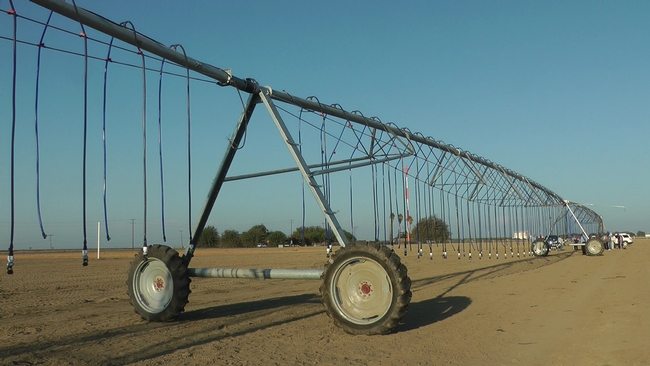
Extensive research by UC scientists and innovative farmers has shown that making the changes can be challenging at first, but in time results in more efficient, environmentally sound and profitable food production systems.
“There’s a sense of inevitability now that these systems will be more widely adopted in California annual cropping systems,” said Jeff Mitchell, UC Cooperative Extension specialist in the Department of Plant Sciences at UC Davis.
| View a two-minute video snapshot of the field day and farm tour at the end of this post. |
The growing interest was demonstrated at a UC field day and farm tour in September in which more than 200 participants visited three farms already successfully implementing conservation practices and three sites at the field station where research on conservation farming practices is underway.
At Five Points Ranch, field day participants stood on an alfalfa field and inched along with an operating center pivot system. Farmer Armando Galvan has added “boom backs” behind the wheels that roll the system through the field. The boom backs make sure the wheel tracks stay dry until the wheels have passed, which prevents wheels from carving deep trenches in wet soil.
At the Morning Star dairy farm, John and JoAnne Tacherra irrigate rolling acres of forage with a center pivot irrigation system and have put the employees who used to undertake the punishing task of moving sprinkler sets to work inside the dairy barn. The center pivot system is controlled with the touch of a button. The combination of advanced nozzle packages and software that manages the pivot speed allow the Tacherras to distribute precise quantities of water and dispense the water with the ideal droplet size for each stage of the crop’s development. The couple now plans to experiment with the application of dairy lagoon water through the center pivot system.
At Farming “D” Ranch in Five Points, logistics manager Scott Schmidt experienced some problems with overhead irrigation this spring. Water was applied on cotton over triangular beds, slipped into the furrows and left seeds dry. Water infiltration was also inhibited when the wetted surface of the field dried into a crust and subsequent irrigation washed off. The crop had to be replanted.
“These sorts of problems can be solved,” Mitchell said. “Carefully designed nozzle packages and soil quality development practices will promote water infiltration.”
No-till farming and the use of cover crops have been shown at the UC West Side Research and Extension Center to enhance soil quality. When the tour returned to the center’s research plots, they viewed a 12-year study where plots have been maintained to compare the long-term effects of standard tillage techniques with no-till or minimum tillage systems, and both tillage methods combined with off-season cover crops.
The soil differences are dramatic.
Using clear canisters for a demonstration, Natural Resources Conservation Service soil conservationist Genett Carstensen poured a cup of water onto soil collected from a tilled plot and onto soil from a no-till plot managed with cover crops. The standard till soil repelled the liquid, which pooled at the top of the container; the no-till soil readily absorbed the water.
“This is what soil quality is,” Carstensen said.
She further demonstrated the soil quality differences by placing dirt clods from the two types of plots in canisters of water. The no-till clod maintained its composure; the clod from the tilled plot began dissolving immediately.
“The no-till clod has glued itself together with dead matter and dead microbes,” she said. “The standard till soil is going to erode and water is going to carry it off.”
At another research field, Steven Kaffka, UC Cooperative Extension specialist in the Department of Plant Sciences at UC Davis, is leading a study of what he calls “energy beets,” formerly known as sugar beets. The trial compares beet production under overhead irrigation and buried drip irrigation. Kaffka believes energy beets will be another competitive crop for California farmers because they can be used to produce ethanol, which will allow farmers to help the state reduce greenhouse gas emissions and achieve climate change goals.
The field day also included a glimpse of future research at the northeast corner of the West Side REC where industry donors have teamed up with UC to create a facility for state-of-the-art overhead irrigation study. Reinke Inc. donated a center pivot system, Senninger Irrigation donated nozzles, and Rain for Rent created an infrastructure that gets water and power to the research plot.
Replicated plots will be pie shaped and different treatments can be applied to each segment with the use of multiple sets of drop hoses. Studies will begin immediately to research deficit irrigation of alfalfa, corn, sorghum and cotton.
“Because of the water situation in California, deficit irrigation is going to be something we will need to know a whole lot more about, for better or for worse,” said Bob Hutmacher, UC Cooperative Extension specialist in the Department of Plant Sciecnes at UC Davis and director of the West Side Research and Extension Center.
View a two-minute video snapshot of the field day and farm tour: